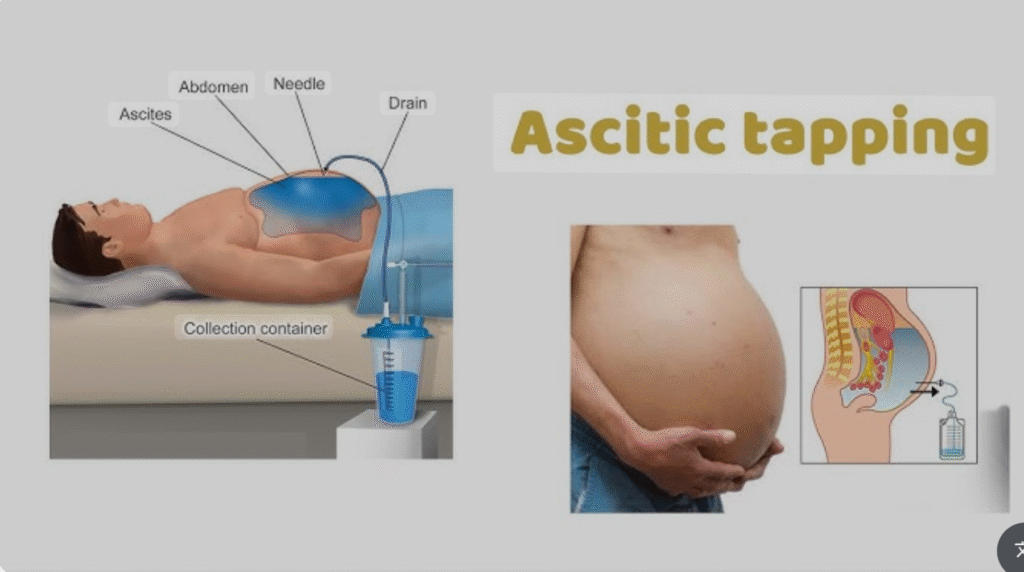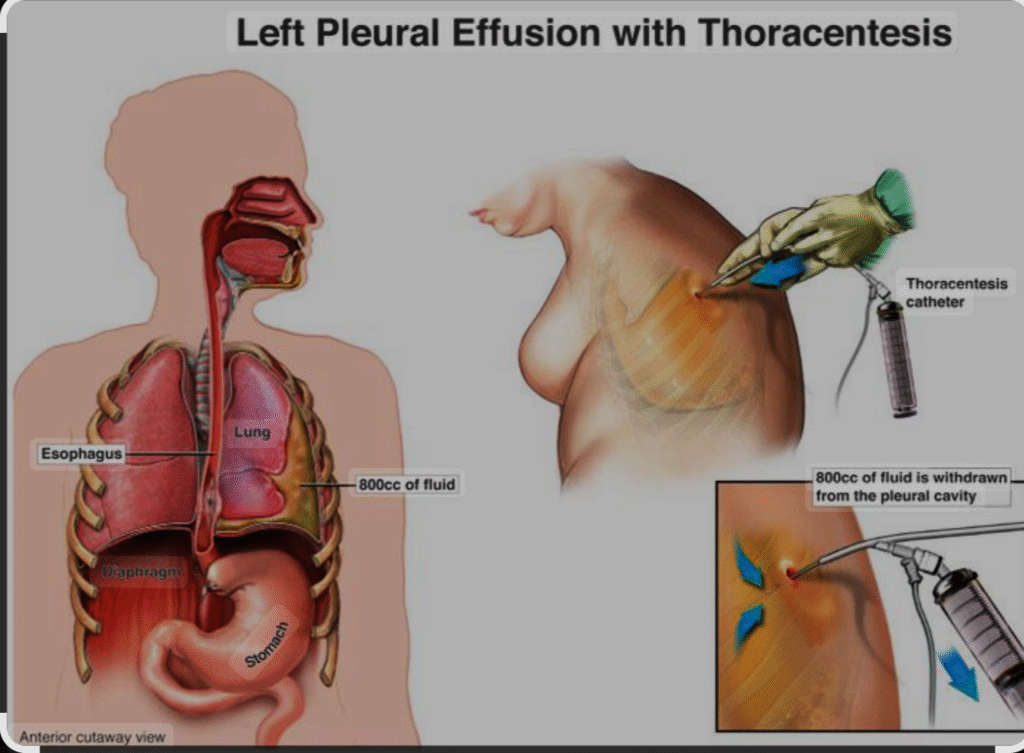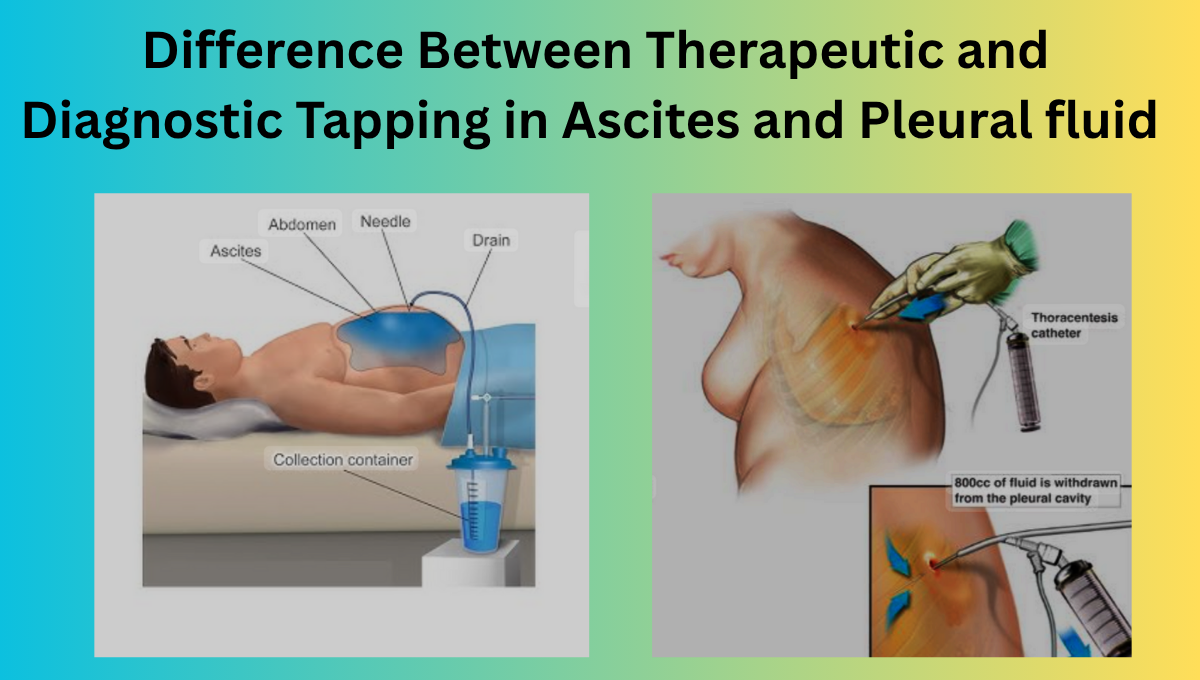Nursing Insights: Difference Between Therapeutic and Diagnostic Tapping in Ascites
Introduction to Accumulation of Bodily Fluids
Envision awakening with a constricted, distended abdomen or experiencing difficulty in respiration due to fluid accumulation in the lungs. Fluid accumulation in the body is not uncommon; it occurs owing to many medical problems, with ascites and pleural effusion being two prevalent examples. Addressing these issues frequently entails treatments referred to as “tapping.”
Let us analyze the significance of these operations, their distinctions, and the role of nurses in assisting patients during them.

What is ascites?
Ascites denotes the collection of fluid within the peritoneal cavity, the space situated between the abdominal organs and the abdominal wall. It typically arises from liver cirrhosis but may also result from cancer, heart failure, or infections such as tuberculosis.
Manifestations encompass
Abdominal distension
Increase in body mass
Dyspnea
Abdominal pain or unease

What is pleural effusion?
Pleural effusion is the accumulation of fluid between the pleural layers that envelop the lungs and the thoracic cavity.
Contributing factors encompass
Congestive heart failure
Pneumonia
Oncology
Pulmonary embolism
Symptoms may include:
Respiratory distress
Thoracic discomfort
Expectoration
Decreased oxygen saturation
Comprehending Tapping in Clinical Practice
What is the definition of “tapping”?
“Tapping” is an informal name for the techniques employed to extract fluid from bodily cavities. It can fulfill two functions:
To do a diagnostic analysis of the fluid (Diagnostic Tapping)
To alleviate symptoms through the extraction of substantial fluid quantities (Therapeutic Tapping)
Categories of Tapping: Summary
Paracentesis—aspiration of ascitic fluid
Thoracentesis—aspiration of pleural fluid
Diagnostic Tapping Clarified Objective of Diagnostic Tapping: The primary aim is to ascertain the cause of fluid accumulation. A specimen is collected utilizing a sterile method and dispatched for laboratory examination to assess for:
Infection
Malignant cells
Protein concentrations
Cell enumeration
Culture and sensitivity testing
Abdominal Paracentesis Procedure in Ascites
The patient often assumes a supine or slightly lateral position.
A tiny needle is introduced into the abdomen under ultrasound guidance.
Volume Withdrawn: Typically, just 30-50 ml is required for analysis.
Laboratory examinations: serum-ascitic albumin gradient (SAAG), white blood cell (WBC) count, and culture And ADA level
Thoracentesis Procedure for Pleural Effusion
Posture: Upright seated, with a slight forward tilt.
Needle insertion: Into the pleural cavity, typically along the mid-scapular line.
Withdrawn Volume: 20-50 ml for diagnostic purposes.
Laboratory Assessments: Cell enumeration, adenosine deaminase (for tuberculosis), and cytological analysis.
💊 An Explanation of Therapeutic Tapping Objective of Therapeutic Tapping
The procedure is performed to alleviate pressure and enhance respiration or comfort. In contrast to diagnostic tapping, greater amounts are extracted.
When is it required?
Abdominal distension resulting in pain or eating difficulties
Acute dyspnea resulting from pulmonary compression
Refractory fluid that is unresponsive to diuretics
Volume and Symptom Alleviation Ascites: A maximum of 5 liters may be extracted at once, with caution.
Pleural fluid: Approximately 1–1.5 liters administered in a single instance to avert re-expansion pulmonary edema.
⚖️ Key Differences Between Diagnostic and Therapeutic Tapping
Comparison Table: Diagnostic vs. Therapeutic Tapping
| Feature | Diagnostic | Therapeutic |
|---|---|---|
| Purpose | Identify cause | Relieve symptoms |
| Fluid volume | Small (20–50 ml) | Large (up to several liters) |
| Risk | Minimal | Higher (hypotension, infection) |
| Frequency | Once for analysis | Repeated if symptoms recur |
| Lab Use | Yes | Sometimes (residual testing) |
⚠️ Risks and Complications of Tapping Immediate Risks: Hemorrhage
Infection
Puncture of an organ
Discomfort at the location
Prolonged Implications
Electrolyte dysregulation
Hypotension
Fluid re-accumulation
Reliance on regular tapping
Nursing Responsibilities in Tapping Procedures Prior to the Procedure
Confirm authorization
Evaluate vital signs and fluid retention
Elucidate the methodology for alleviating anxiousness.
Confirm the bladder is devoid of contents (before paracentesis).
During the procedure, assist the physician.
Preserve a sterile environment
Observe the patient’s status
Post-procedural Care and Surveillance Assess for hypotension or vertigo
Observe output and record
Administer a dressing to the puncture site.
Inform the patient of the indicators of infection.
Nursing Management of Ascites:
Assessment and Monitoring—Daily Weight
Measurement of abdominal circumference
Fluid intake and outflow
Evaluation of respiratory function
Check for serum protein and PT/INR value.
Ask for an albumin 20% transfusion after therapeutic ascites tapping (please note—no albumin transfusion is needed after diagnostic tapping)
Management of Diet and Fluid Intake
Reduced-sodium regimen
Implement fluid restriction in the presence of hyponatremia.
Promote the consumption of small, frequent meals
Patient Education and Support Medication Adherence (e.g., diuretics)
Indicators of deterioration (disorientation, significant edema)
Indications for hospital readmission
Case Study: Management of Ascites in a Cirrhotic Patient
Mr. Ramesh, a 58-year-old male with liver cirrhosis, presents with exacerbated abdominal distension and dyspnea. Following the ultrasound confirmation of ascites, he undergoes therapeutic paracentesis, resulting in the removal of 4.5 liters of fluid. The nursing care encompassed:
Continuous surveillance of vital signs
Infusion of albumin to avert hypotension
Instruction on sodium consumption and subsequent management
🔚 Conclusion
Tapping is essential in the management of both ascites and pleural effusion, whether for diagnostic or therapeutic purposes. Understanding the purpose, process, and nursing implications of each type facilitates the provision of safe, effective, and compassionate care. Nurses are integral to this process, encompassing preparation to recuperation. Appropriate knowledge and behaviors can markedly enhance patient outcomes.
❓FAQs
1. Is diagnostic tapping uncomfortable?
It may induce slight discomfort; however, local anesthetic is typically administered to alleviate pain.
- Is it possible to perform tapping at home?
These are sterile operations that must only be conducted in a hospital or clinical environment by qualified individuals. - What is the frequency of therapeutic tapping sessions?
The frequency is contingent upon the patient’s condition. For refractory ascites, weekly intervention may be necessary. - Which laboratory analyses are conducted on diagnostic ascitic fluid?
Tests including cell count, culture, cytology, and serum-ascitic albumin gradient (SAAG). - Why do patients with ascites frequently have albumin infusion following paracentesis?
To sustain intravascular volume and avert circulatory dysfunction following the removal of substantial fluid quantities.


1 thought on “Nursing Insights: Difference Between Therapeutic and Diagnostic Tapping in Ascites”